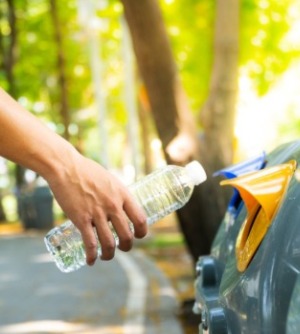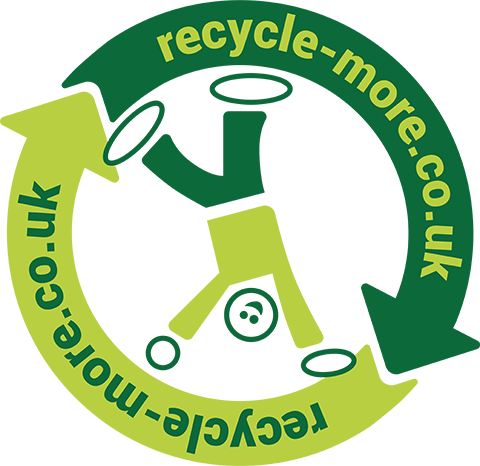
Plastic- Recycling Process
Plastic Packaging
There are a lot of different polymer types and forms of plastic in the waste stream. This makes it more difficult to sort and reprocess than other materials. Due to the light nature of most plastic packaging it means that a lot needs to be collected to make it economic to do so. Therefore, most collections have focused on key packaging types where there is an end market in place i.e. plastic bottles, which are heavier than most other plastics and therefore relatively easy to handle and sort.
While it is technically possible to recycle most plastic polymers, the complexity and cost of doing so has prevented this happening in the past. There are some reprocessors that will take mixed polymers; however, the materials produced tend to be of low grade and value.
Another issue that plastics reprocessors face is that sometimes food waste is left on packaging. Often packaging can consist of more than one polymer type, which makes it more difficult to recycle.
Reprocessing technology is constantly improving and more uses are being found for waste plastics...
Plastic bottles
Plastic bottles are the most commonly collected plastic packaging type. This is because they are easy to sort and there are well developed markets for the recyclate. The bulk of bottles are made from PET or HDPE, which account for about 90%.
Note: The UK has a much higher use of HDPE bottles than most countries due to its use for containing milk.
Plastic bottles are normally made from one of only four polymer types and are very easily identified, both by members of the public and those sorting the collected bottles. The four polymer types used are:
- PET (e.g. fizzy drink bottles and squash bottles)
- HDPE (e.g. milk bottles and detergent bottles)
- PP (e.g. ketchup bottles)
- PVC (e.g. large squash bottles). Although the use of PVC in such applications is in decline

Pots, tubs and trays
Many local authorities are now allowing residents to place plastic pots, tubs and trays in their kerbside collection containers. They may also be accepted at recycling centres.
Yogurt pots
Several manufacturers now use PET yogurt pots, which are the same polymer type as plastic bottles. This means that PET yogurt pots can be recycled.
However, some yogurt pots are made from polystyrene and are not generally accepted in plastic recycling schemes . Polystyrene has an entirely different make-up to the polymers used in plastic bottles and there are currently limited outlets for this material. Again, there are fewer clearly identified end markets for the material at this time. The quality of the material is often compromised as a result of food contamination, making it necessary for householders to thoroughly wash the cartons before depositing for recycling.
In areas where yogurt pots and rigid food containers have been collected, the value of the material has been diminished by a lack of thorough cleaning.
Black food trays
Due to the fact that most sorting plants use optical sorting techniques to identify the different polymer types, they are not able to identify black plastic trays e.g. those used for ready meal packaging. Currently most local authorities will not collect this type of packaging. If they are accepted, it is likely to be rejected at the sorting plant and end up in the residual waste stream and will not be recycled.
Trials are taking place currently where a food tray with slightly different pigment (which still appears to be black) can be identified by its polymer type by optical sensors at sorting plants.
Margarine tubs
Items such as margarine tubs and rigid food containers are often made from a very wide range of polymer, many of which are blends. These are much more difficult to identify and separate efficiently. Sometimes margarine tubs absorb some of the oils and fats from the food product.
Flowerpots
We frequently get asked if flowerpots can be recycled. The majority of flowerpots are made from polypropylene (PP), although some are made from polystyrene. As in the case of rigid food containers and some yogurt pots, there are few outlets for collected material and a higher level of contamination mainly due to soil.
That said, some garden centres do accept them for recycling. In addition, some retailers are now selling plants that can be planted directly into the ground while still inside their container, as the packaging is bio-degradable.
Carrier bags and films
The vast majority of film that is currently collected for recycling is from businesses who produce large volumes of this waste, for example, stretch-wrap around pallets from the delivery of incoming goods.
Only small amounts of household films are currently recycled. Most household collections will not accept plastic films due to problems with separating them from other materials. They can also get tangled up in the machinery at sorting plants. In addition, the very lightweight nature of the material means that it is of low value and it may be highly contaminated.

Carrier bag recycling facilities are available in some supermarkets and these facilities are becoming more widespread. Some supermarkets may also allow customers to deposit other packaging films, such as frozen food bags, into their recycling banks.
Film that is recycled is generally only used for low-grade applications, such as bin liners, because of the contamination effect of the printing ink, making it only suitable for dark colours, such as grey or black.





